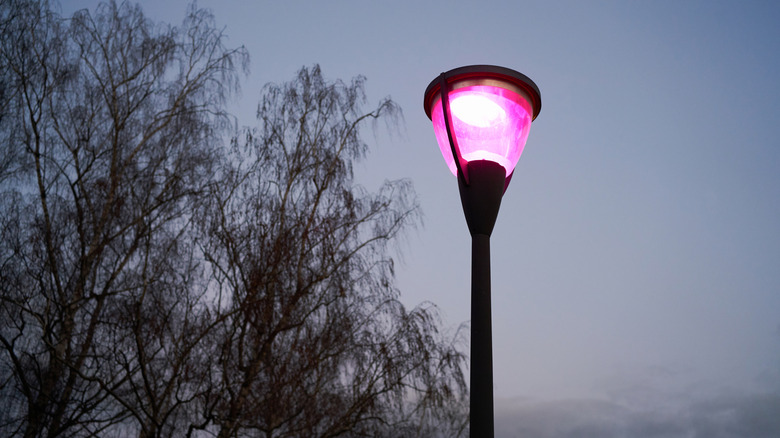Why Are Some Streetlights Turning Purple?
Red light means stop. Green light means go. Purple light means ... wait, what? Fortunately, intersection signals are still working fine, but the same can't be said for America's streetlights, hundreds of which have turned purple, seemingly apropos of nothing. Reports of the bizarre phenomenon have emerged from at least 30 states, dating back to 2021. The most notable case so far came out of Milwaukee, Wisconsin, where residents were left baffled after approximately 300 of the city's streetlights started glowing like radioactive grape soda. Of course, the strange shift has birthed plenty of conspiracy theories, but the real explanation comes down to simple science, and a bit of human negligence.
Over the course of the 2010s, municipalities across the United States began replacing their longstanding gas-and-filament street lamps with LED (light-emitting diode) street lamps. LEDs offer many advantages over old metal halide lamps, the most important being that they shine bright for a longer period at less cost overall. The way LED lights work avoids the use of gas and filament to create a more compact and energy efficient lighting source. That makes them perfect for something like street lamps, where you need a durable light that won't cost the city too much money and labor to maintain. Unfortunately, LEDs have just one problem: they don't come in white. In order to explain why, and what lighting designers have tried to do about it, you need to know some basics about the visible light spectrum.
Why making LEDs white is so tricky
If you are old enough to remember the days when LED-lit products were first hitting the market, you'll remember that the earliest renditions of this technology emitted an ice-blue colored light that, though effective, was so much colder than the warm white lights people were accustomed to that it was harsh on the eyes. LEDs can emit a few different colors on the visible light spectrum, but not the color white, so in order to mimic the hue of older gas-and-filament lights, manufacturers of LEDs need to employ some creative ingenuity.
In order to make an LED shine white instead of ice blue, the diodes are coated in a mixture of phosphor and silicon. Phosphor is a synthetic material that illuminates in the presence of radiation. It is commonly used to prevent lightbulbs from emitting UV radiation, but also has the benefit of converting that harsh blue LED glare into a friendlier white glow. Silicon is added to make the phosphor adhere to the LED. Unfortunately, it doesn't always work the way it should. If the silicon starts to degrade, it creates cracks in the phosphor layer that let the blue LED light leak through, casting a purple glow.
Streetlights turning purple is dangerous because it makes them appear dimmer, making it harder for people to see their way clearly. Fortunately, the bulbs are easy to replace, but manufacturers will need to uphold higher quality control standards going forward.

